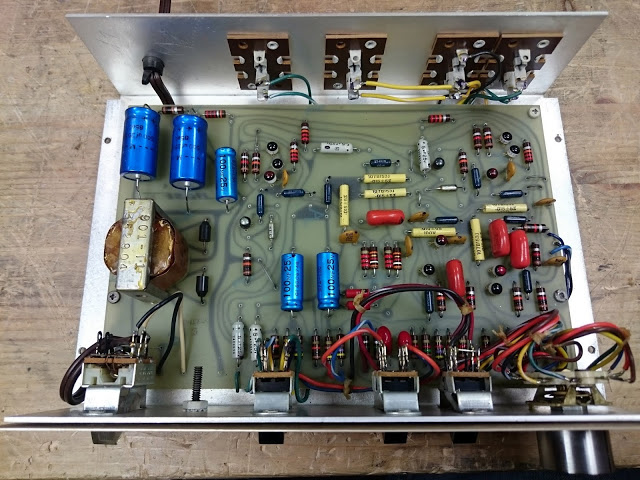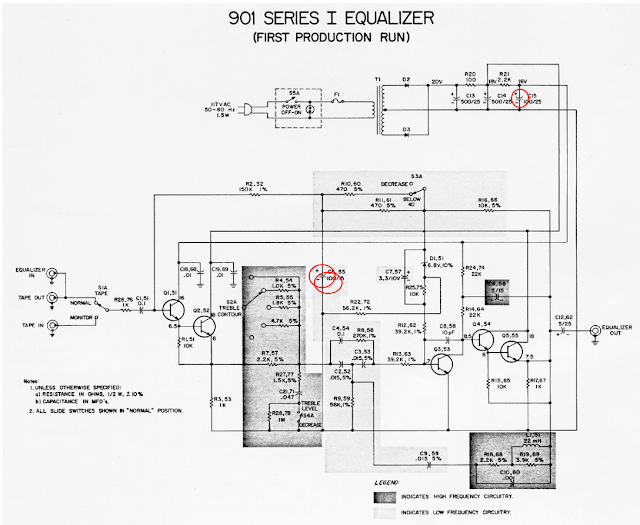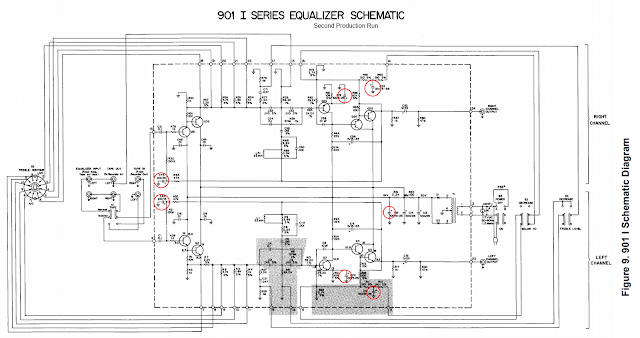Bose 901 Series I Active Equalizers came in two varieties, which can be used interchangeably, but have fairly different circuit designs. It’s simple to tell them apart for ordering parts for a repair with a quick inspection of the inside.
Both have the same faceplate. Most of the Early Production models came with a solid wood case instead of the veneered particle board the second run used. The lowest serial number Early Production models used screws and a slightly narrower spacing on the rear-panel RCA jacks vs. rivets used on higher serial numbers and in the second run.

The Early Production model extends to at least serial #7346, but likely higher. The components are arranged somewhat chaotically, and there are no silkscreened labels on the board.

The second production run has components arranged in neat rows, and a significantly expanded array of electrolytic capacitors along the rear of the PCB near the RCA jacks.

Schematics of each production run, with the large power supply electrolytic capacitors highlighted. (Output capacitors are not circled.)
Both models of equalizer also use different signal capacitors. The First Production run uses a total of 18: (.1 x 2, .047 x 2, .015 x 6, .01 x 4, .001 x 2) while the Second Production run uses only 12: (.1 x 4, .047 x 2, .015 x 6).
There is also a rare revision of the Series I PCB which turns up in certain Series II Active Equalizers. Note a number of unpopulated components and the same power supply section as the Series I, along with wiring directly on the back of the contour switch. The Series II Active Equalizer produces the same curve as the Series I, just with a further optimized circuit with a handful of component changes, and could also be used with any Series I or Series II speaker system.


The equalizer is a necessary component of the Bose 901 speaker system, Bose’s highest-end hi-fi equipment. The speakers are specially designed in a way that requires the signal to be equalized and pre-amplified, and if you don’t use the Active Equalizer they’ll really sound pretty bad. It’s surprising how many people have forgotten this fact about the 901-series speakers over the years, but the lack of using an equalizer might be where derogatory slogan “Bose: No Highs, No Lows” came from. Read more about why the Active Equalizer is necessary in a response to a reader’s question.
Most Active Equalizers are getting pretty old, and many components like the electrolytic capacitors have a limited service lifetime. As they age, their performance degrades and you’re left with reduced frequency response or other problems. Read more about exactly what goes into an overhaul of an Active Equalizer.



is it possible to use a new Active equalizer with the BOSE 901 series 1?
Pingback: Bose 901 Series 1 Active Equalizer Repair [Vintage Hi-Fi] | RETROVOLTAGE
Pingback: Mailbag: Is The Bose 901 Equalizer Really Necessary? | RETROVOLTAGE
Good info Thanks KF!